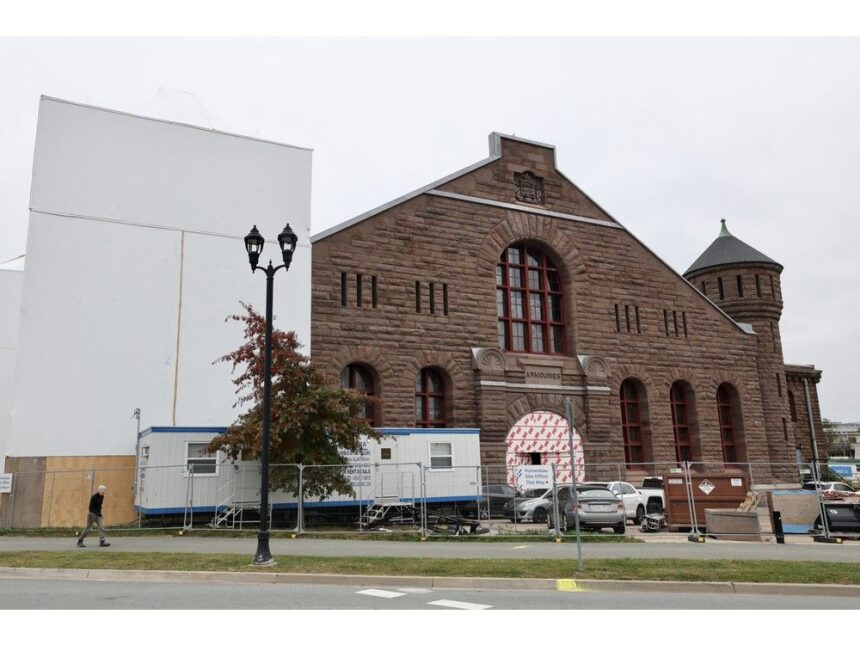The Halifax Armoury under construction on Oct. 20. Photo by Tim Krochak /The Chronicle HeraldArticle contentJust when it seemed that years of construction were finished at the Halifax Armoury, the scaffolding is back up again.THIS CONTENT IS RESERVED FOR SUBSCRIBERS ONLY.Subscribe now to access this story and more:Unlimited access to the website and appExclusive access to premium content, newsletters and podcastsFull access to the e-Edition app, an electronic replica of the print edition that you can share, download and comment onEnjoy insights and behind-the-scenes analysis from our award-winning journalistsSupport local journalists and the next generation of journalistsSUBSCRIBE TO UNLOCK MORE ARTICLES.Subscribe or sign in to your account to continue your reading experience.Unlimited access to the website and appExclusive access to premium content, newsletters and podcastsFull access to the e-Edition app, an electronic replica of the print edition that you can share, download and comment onEnjoy insights and behind-the-scenes analysis from our award-winning journalistsSupport local journalists and the next generation of journalistsRegister to unlock more articles.Create an account or sign in to continue your reading experience.Access additional stories every monthShare your thoughts and join the conversation in our commenting communityGet email updates from your favourite authorsSign In or Create an AccountorArticle contentThe National Historic site, also known as the Halifax Armouries or the North Park Armoury, took only three years to build when it opened in 1899, but the restoration is taking much longer.Article contentArticle contentThe second phase of the restoration, which was supposed to start in 2023, got going earlier this year. The entire project is already over budget by $30 million to $160 million, and those costs will be higher than that, guaranteed. It cost $175,000 to build it in the 19th century.Article contentArticle content“It does cost a lot of money, but metal siding wouldn’t do. It does preserve the building for the next three or four generations, and that’s a good thing,” said local historian and author Blair Beed.Article content“They talk sometimes about modern buildings being icons and I haven’t seen many of those, but the Armoury really is an icon. It has interested me and probably other people like me since we were kids — we had our own castle on the Common and I’m glad to see (it’s) being well looked after.”Article content The Halifax Armoury, before any construction, in this file photo from 2015. Photo by Christian Laforce /The Chronicle HeraldArticle contentPhase oneArticle contentA big chunk of the construction in the first phase was to correct the west wall that was pushed over from the Halifax Explosion. Finding the right, matching sandstone was a chore.Article content“Extensive global research identified only two compatible sources for the North Park Armoury: N.S. red sandstone and Callow Hill Stone,” said Kened Sadiku, a spokesperson for the Department of National Defence, in an email.Article contentArticle content“Due to the high porosity of the N.S. red sandstone, designers opted to use Callow Hill Stone from the U.K. for the window sills … For all remaining stone, the contractor is using salvaged N.S. sandstone where possible supplemented with new material from Callow Hill.”Article content People line up outside the Halifax Aroury to pick up food after the Halifax Explosion in 1917. Photo by FileArticle contentThe first phase was originally projected to be done in 2019, but was finished in 2022.Article content“The only thing that didn’t go back was the initials V.R. for Victoria Regina, for Queen Victoria, (over the door). That disappeared because they made the door bigger for the trucks that are bigger that have to go in through that door,” said Beed.Article contentWhat’s happening in the second phaseArticle contentThis year, the Department of National Defence awarded a $60.6 million contract to Bedford-based Pomerleau for the first package of work.Article contentThe second phase is divvied up into two parts: rehabilitating the other walls, roof, foundations and windows, while the final component focuses on upgrading the interior with energy-efficient heating and cooling systems, LED lighting and solar panels.
Halifaxs castle on the Common in scaffolding, again











